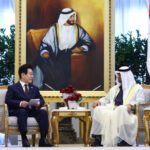
For years, South Korea was one of the most reliable markets for European luxury houses, where names like Chanel, Gucci and Louis Vuitton seemed immune to economic downturns.
Now, weary of relentless price hikes, Korean shoppers are indulging their taste for luxury with American labels such as Ralph Lauren and Coach – once dismissed as passé but newly revived – echoing a trend already underway worldwide.
According to the retail industry on Thursday, sales of Ralph Lauren’s Korean operations in the fiscal year ended March 2025 hit 533.7 billion won ($383.1 million), up 3.1% from a year earlier. Operating margin stood at 30.2%.
At Lotte Department Store, sales of both Ralph Lauren and Coach rose by double digits in the first eight months this year.
Shinsegae Department Store, one of Korea’s top three department stores along with Lotte and Hyundai, reported sales of Ralph Lauren and Coach climbed 7.2% and 3%, respectively, over the same period, while Coach sales at Hyundai Department Store recorded a more than 30% jump.
Items from Coach’s collaboration with the Korean contemporary label Matin Kim sold out within days of a pop-up launch, with items now fetching twice their original price on resale platforms.
Ralph Lauren and Coach were popular in Korea until the early 2000s but steadily lost ground to European competitors, which aggressively expanded into new markets.

Asia’s fourth-largest economy, with its insatiable appetite for luxury, became a particularly important market for them – and also the place where price increases were the steepest.
However, those relentless hikes, combined with an economic slowdown and new US tariffs on European goods, have dulled Koreans’ enthusiasm for European luxury.
A WORLDWIDE SHIFT
The trend isn’t confined to Korea. In the US, Coach and Ralph Lauren have both bounced back strongly.
Tapestry, the parent company of Coach, reported sales of $7 billion for the fiscal year ended June 2025, up 5.1% from the prior year. Over the same period, Coach increased sales by 14%.
Ralph Lauren’s sales in the April-June period rose nearly 14% from a year ago to $1.7 billion, with an operating margin improving 2.7 percentage points to 17%.
Buoyed by strong performance, shares in Ralph Lauren and Tapestry have gained 35.0% and 60.4%, respectively, this year.
Their comeback has been fueled by marketing campaigns aimed at younger consumers, with Coach adding a million new customers in North America in the second quarter, most of them millennials or Gen Z.
Part of the appeal is price. In recent years, European houses have lifted tags so quickly that younger and middle-class shoppers have been left with fewer options.
American brands have moved into the gap, investing heavily in marketing – often through TikTok, Instagram and YouTube – and positioning themselves as affordable luxury.
Coach and Ralph Lauren’s ad budgets have swelled to about 10% and 7% of sales, respectively, last year versus their historic average of around 4%.

They also fared well in China, the biggest market for European luxury brands.
Ralph Lauren and Coach reported sales growth of 30% and 22%, respectively, in the world’s second-largest economy last quarter, attracting price-sensitive Chinese consumers amid a prolonged economic downturn.
The contrast is stark.
LVMH, the world’s leading luxury products group, saw sales in the first half down 4% from a year ago, while its operating profit shrank 15%.
Kering’s sales and profit also contracted 16% and 46%, respectively, largely due to the sluggish performance of its mainstay brand Gucci.
Analysts blame stagnant spending in China, punishing US tariffs and years of aggressive price increases.
Seeking to revive their past prestige, more than a dozen labels of European luxury houses, including Gucci, Dior and Chanel, have hired new creative designers.
Their collections will debut in September, though it will take several quarters to see whether fresh designs can reverse the slide.
By Jae-Kwang Ahn
ahnjk@hankyung.com
Sookyung Seo edited this article.















